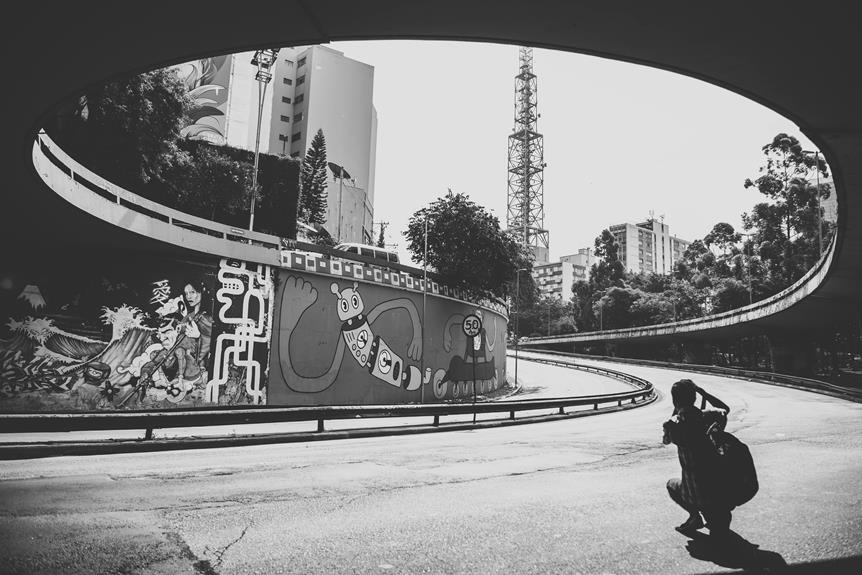Tone in Art

Understanding tone in art is essential because it shapes the emotional impact and depth within a piece. You manipulate light and dark tones to evoke different feelings and guide the viewer’s eye. For instance, dark tones can add drama and mystery, while light tones bring focus and joy. Techniques like chiaroscuro and tonal gradation enhance these effects. By mastering tone, you can breathe life into your works, creating immersive and emotionally compelling experiences. Famous pieces like Van Gogh’s ‘Starry Night’ or Caravaggio’s ‘The Calling of Saint Matthew’ brilliantly showcase this. Discover how different tones can transform your artistic vision.
Key Points
- The tone in art refers to the lightness or darkness of colours, shaping depth and emotional impact.
- Dark tones add drama and mystery, creating depth in compositions.
- Light tones emphasize focal points, creating brightness and lifting the viewer’s spirits.
- Techniques like chiaroscuro and sfumato manipulate tones to create contrast and atmospheric effects.
- Artists like Rembrandt and Caravaggio use tone to enhance storytelling and evoke specific emotions.
Understanding Tone
To truly grasp the concept of tone in art, you need to recognize how the lightness or darkness of colours can shape depth, form, and emotional impact. Tone isn’t just about shading; it’s a powerful tool for conveying emotions and atmosphere.
By manipulating tones, artists can create striking contrasts that highlight focal points and guide your eyes through the composition. The interplay of light and dark tones can evoke different emotional responses, making a piece feel sombre, vibrant, or serene.
Understanding tone allows you to appreciate the subtle nuances and the visual storytelling embedded in an artwork. It’s this mastery of tone that breathes life into a canvas, transforming simple colours into a rich, immersive experience.
Types of Tone
Recognizing the different types of tone—dark, mid, and light—is essential for appreciating how artists create depth, contrast, and emotional resonance within their work.
Dark tones add drama and depth, making elements recede and giving a painting a sense of mystery.
Light tones, on the other hand, highlight specific areas or objects, drawing your eye and emphasizing focal points.
Mid tones act as the bridge, balancing dark and light areas, providing smooth connections, and ensuring the composition remains cohesive.
By mastering these tones, artists can define form, create atmosphere, and enhance visual interest.
This understanding allows you to perceive the nuanced ways artists manipulate light and shadow, showcasing their technical prowess and creative vision.
Tone and Emotion
Artists frequently wield tone as a powerful tool to shape the emotional landscape of their artwork, influencing how viewers feel and interpret each piece.
Dark tones can evoke sombre or mysterious feelings, immersing you in a sense of depth and introspection.
Conversely, light tones create a sense of brightness or joy, lifting your spirits and drawing you into the artwork’s warmth.
By strategically using tone, artists evoke specific emotions and enhance their storytelling. The choice of tones greatly impacts how you connect with and interpret the artwork on an emotional level.
Understanding these emotional nuances can deepen your appreciation for the artist’s intentions, allowing you to engage more profoundly with the artwork’s message.
Techniques for Using Tone
Mastering various techniques for using tone can greatly enhance the emotional and visual impact of your artwork. Techniques like chiaroscuro create dramatic contrasts between light and dark, adding depth and intensity.
Cross-hatching lets you build up different tones and textures using intersecting lines, ideal for intricate details. Tonal gradation involves smoothly shifting between tones to convey depth and form, making your pieces more lifelike.
Sfumato, a technique popularized by Leonardo da Vinci, creates soft, blurred edges and atmospheric effects through subtle tonal changes. Finally, scumbling involves applying a thin, broken layer of lighter tone over a darker tone to introduce texture and depth.
Each method offers unique ways to manipulate light and shadow, enriching your artistic expression.
Influential Artworks
When examining influential artworks, it’s evident that the strategic use of tone plays a pivotal role in shaping their emotional and visual impact.
In Vincent van Gogh’s ‘Starry Night‘, swirling tones create a sense of movement and emotional intensity.
Rembrandt’s ‘The Night Watch‘ uses contrasting tones to add depth and direct focus to key characters.
Georgia O’Keeffe’s ‘Jimson Weed/White Flower No. 1‘ employs light tones to highlight delicate floral details.
Caravaggio’s ‘The Calling of Saint Matthew‘ masterfully uses chiaroscuro, with sharp light-dark contrasts, to heighten drama and focus.
Edward Hopper’s ‘Nighthawks‘ uses a subdued global tone to evoke feelings of isolation and contemplation in an urban landscape.
Each artwork demonstrates how tone profoundly influences viewer perception and interpretation.
Frequently Asked Questions
What Is Value and Tone in Art?
Value refers to the lightness or darkness of colors, while tone encompasses these variations to create depth, contrast, and mood. You’ll see tonal values in grayscale, helping convey shadows, highlights, and the illusion of form.
What Is Tone and Shading in Art?
You see tone as the lightness or darkness of colours, creating depth. Shading, a technique involving shadows and highlights, produces various tones. Together, they enhance mood, atmosphere, and focus, revealing the artist’s intent.
What Is an Example of Tone Painting?
You can see tone painting in Vincent van Gogh’s ‘Starry Night.’ The swirling, vibrant colours and expressive brushstrokes create a dynamic, emotional landscape, demonstrating how tone sets the mood and atmosphere in art.
What Is Tone in Performing Arts?
You analyze tone in performing arts by examining voice quality, pitch, and expression in acting, music, and dance. It’s vital because it shapes emotions, conveys character traits, and profoundly impacts the audience’s experience and interpretation.
Conclusion
By mastering tone in art, you’ll develop the capability to evoke deep emotions and create intricate atmospheres. Whether exploring its types or employing various techniques, your understanding of tone will enhance your artistic expression.
Influential artworks demonstrate how effectively tone can communicate profound messages. As you refine your skills, you’ll discover the powerful impact tone has on your audience, transforming your art into a compelling narrative that resonates on multiple levels.
Author: Jessica Hartley

